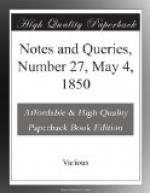Hanover Square.—“The statue of William Pitt, by Sir Francis Chantrey, set up in the year 1831, is of bronze, and cost 7000l. I was present at its erection with Sir Francis Chantrey and my father, who was Chantrey’s assistant. The statue was placed on its pedestal between seven and eight in the morning, and while the workmen were away at their breakfasts, a rope was thrown round the neck of the figure, and a vigorous attempt made by several sturdy Reformers to pull it down. When word of what they were about was brought to my father, he exclaimed, with a smile {436} upon his face, ‘The cramps are leaded, and they may pull to doomsday.’ The cramps are the iron bolts fastening the statue to the pedestal. The attempt was soon abandoned.”
Hyde Park Corner.—“There were cottages here in 1655; and the middle of the reign of George II. till the erection of Apsely House, the small entrance gateway was flanked on its east site by a poor tenement known as ‘Allen’s stall.’ Allen, whose wife kept a moveable apple-stall at the park entrance, was recognised by George II. as an old soldier at the battle of Dettingen, and asked (so pleased was the King at meeting the veteran) ‘what he could do for him.’ Allen, after some hesitation, asked for a piece of ground for a permanent apple-stall at Hyde Park Corner, and a grant was made to him of a piece of ground which his children afterwards sold to Apsley, Lord Bathurst. Mr. Crace has a careful drawing of the Hyde Park Corner, showing Allen’s stall and the Hercules’ Pillars.”
Pall Mall.—“Mr. Fox told Mr. Rogers, that Sydenham was sitting at his window looking on the Mall, with his pipe in his mouth and a silver tankard before him, when a fellow made a snatch at the tankard, and ran off with it. Nor was he overtaken, said Fox, before he got among the bushes in Bond Street, and there they lost him.”
Lansdowne House.—“The iron bars at the two ends of Lansdowne Passage (a near cut from Curzon Street to Hay Hill) were put up late in the last century, in consequence of a mounted highwayman, who had committed a robbery in Piccadilly, having escaped from his pursuers through this narrow passage by riding his horse up the steps. This anecdote was told by the late Thomas Grenville to Sir Thomas Frankland Lewis. It occurred while George Grenville was Minister, the robber passing his residence in Bolton Street full gallop.”
Newcastle House.—“The old and expensive custom of ‘vails-giving,’ received its death-glow at Newcastle House. Sir Timothy Waldo, on his way from the Duke’s dinner table to his carriage, put a crown into the hand of the cook, who returned it, saying: ‘Sir, I do not take silver.’ ‘Don’t you, indeed?’ said Sir Timothy, putting it in his pocket; ’then I do not give gold.’ Hanway’s ‘Eight Letters to the Duke of ——,’ had their origin in Sir Timothy’s complaint.”




